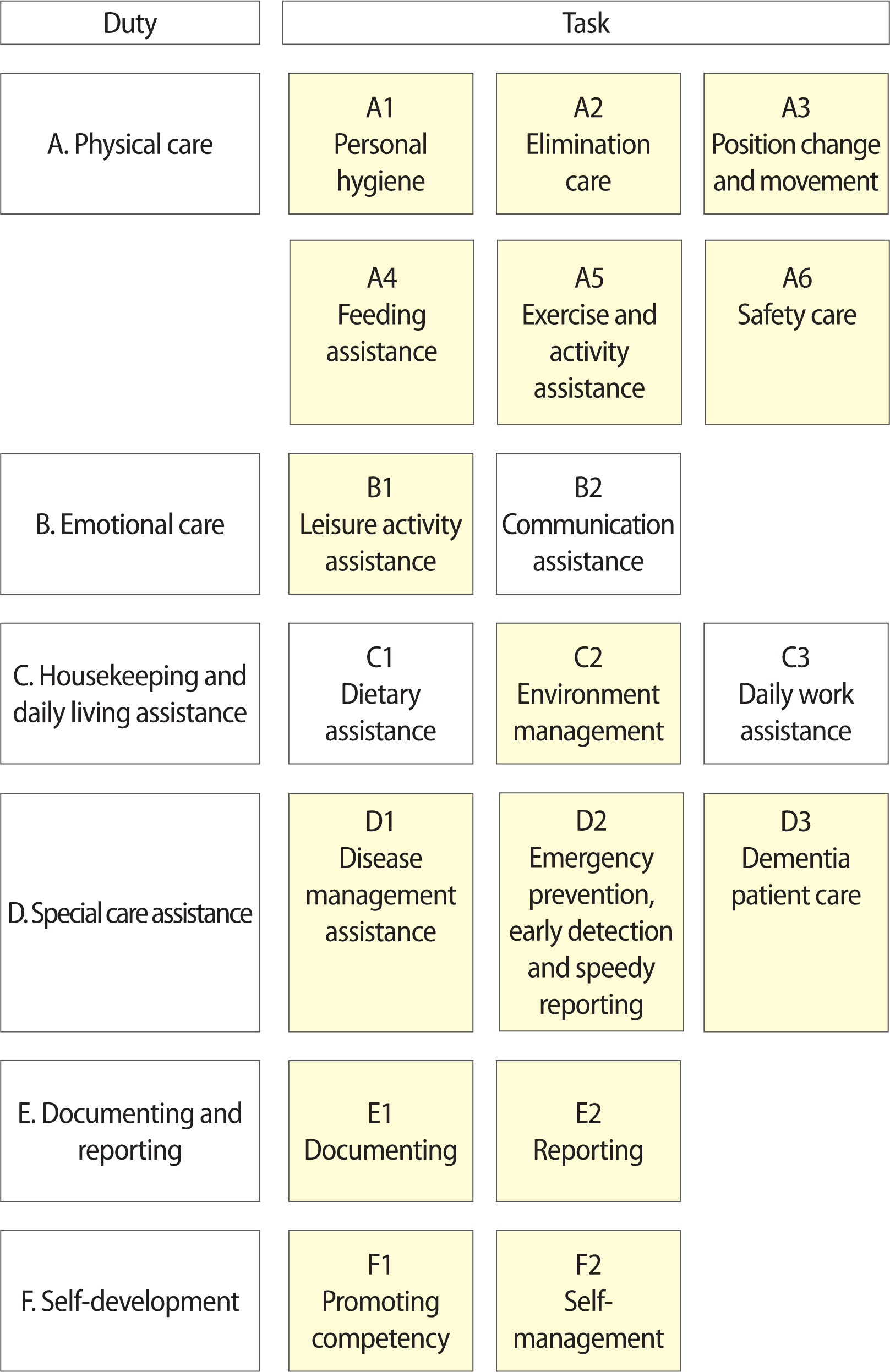J Educ Eval Health Prof.
2012;9:2.
A job analysis of care helpers
- Affiliations
-
- 1Department of Nursing, Soonchunhyang University, Cheonan, Korea. ssj1119@sch.ac.kr
- 2Institute of Medical & Welfare Resources, Seoul, Korea.
- 3Department of Nursing, Andong Science College, Andong, Korea.
- 4Hamkkeguleum Health Cooperative, Seoul, Korea.
- 5Department of Health Policy and Management, Jeju National University School of Medicine, Jeju, Korea.
- 6Department of Social Welfare, Hallym University, Chuncheon, Korea.
Abstract
- The aim of this study was to examine the roles of care helpers through job analysis. To do this, this study used the Developing A Curriculum Method (DACUM) to classify job content and a multi-dimensional study design was applied to identify roles and create a job description by looking into the appropriateness, significance, frequency, and difficulty of job content as identified through workshops and cross-sectional surveys conducted for appropriateness verification. A total of 418 care helpers working in nursing facilities and community senior service facilities across the country were surveyed. The collected data were analyzed using PASW 18.0 software. Six duties and 18 tasks were identified based on the job model. Most tasks were found to be "important task", scoring 4.0 points or above. Physical care duties, elimination care, position changing and movement assistance, feeding assistance, and safety care were identified as high frequency tasks. The most difficult tasks were emergency prevention, early detection, and speedy reporting. A summary of the job of care helpers is providing physical, emotional, housekeeping, and daily activity assistance to elderly patients with problems in independently undertaking daily activities due to physical or mental causes in long-term care facilities or at the client's home. The results of this study suggest a task-focused examination, optimizing the content of the current standard teaching materials authorized by the Ministry of Health and Welfare while supplementing some content which was identified as task elements but not included in the current teaching materials and fully reflecting the actual frequency and difficulty of tasks.
Keyword
MeSH Terms
Figure
Reference
-
1. Doty P, Liu K, Wiener J. An overview of long-term care. Health Care Financ Rev. 1985; 6:69–78.2. Kim HJ. Impacts of Home care service on the service satisfaction level of the elderly [dissertation]. Daejeon, KR: Mokwon University;2009.3. Ministry for Health, Welfare and Family Affairs. The act on the long-term care insurance for the elderly. Seoul: Ministry for Health, Welfare and Family Affairs;2009.4. Kim HS, Kim S, Kang JS. The study on education course for exercise instructors for dementia by DACUM job analysis. J Korean Gerontol Soc. 2008; 28:357–75.5. Park YH. Influences of environmental factors of care providers in medical and welfare service facilities for the elderly on their job stress [dissertation]. Gyeongsan: Daegu Haany University;2010.6. Lee JW, Seomun JH. A study on problems and improvement of home-help services of long-term care insurance. J Korea Gerontol Soc. 2009; 29:149–75.7. Lee SS. Factors affecting care workers’ job satisfaction [dissertation]. Yeongju: Dongyang University;2009.8. Yang BS. How do institutionalization of caregiver system in hospital. Mon Labor Rev. 2006; 18:77–87.9. Jang OJ. A study on the job activity of caregiver in general hospital nurse. J Hyejeon Coll. 2003; 21:429–54.10. US Department of Labor Statistics. Occupational outlook handbook, 2009–09 ed [Internet]. NE Washington, DC: US Bureau of Labor Statistics;2009. [cited 2010 Oct 15]. Available from http://www.bls.gov.11. Lim J. Difference between Korean and Japan on the long-term care insurance for elderly. Seoul: Institute of Medical and Welfare Resources;2010.
- Full Text Links
- Actions
-
Cited
- CITED
-
- Close
- Share
- Similar articles
-
- Factors Affecting Job Satisfaction of In-Home Child Care Helpers: Focusing on Child-Care Efficacy, Job Efficacy, and Health Promoting Lifestyle
- The Effects of Child Care Helpers' Emotional Labor and Job Stress on Their Burnout
- Influencing Factors on Service Quality of Care Helpers Working for the Elderly in Long Term Care
- Workplace Violence Experiences among Care Helpers
- Development of Patient Transfer Techniques based on Postural-stability Principles for the Care Helpers in Nursing Homes and Evaluation of Effectiveness


